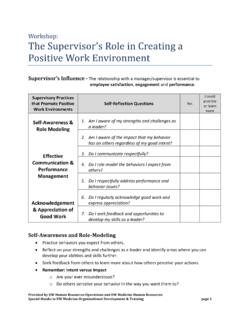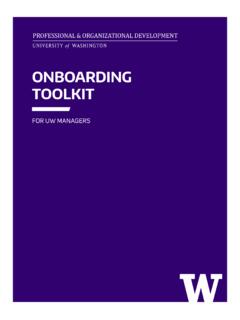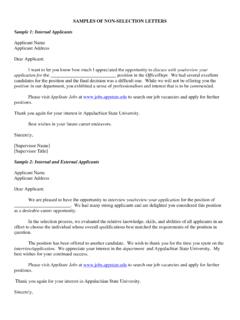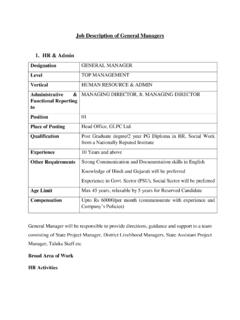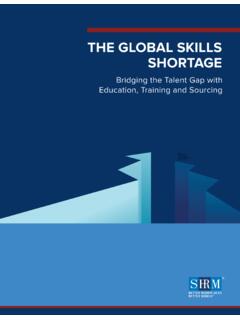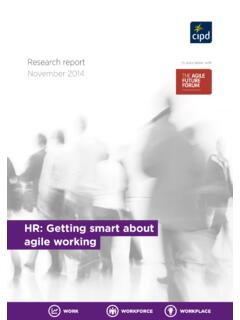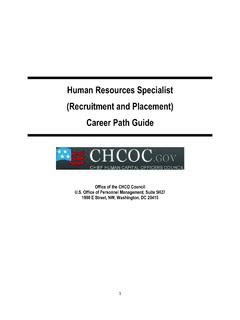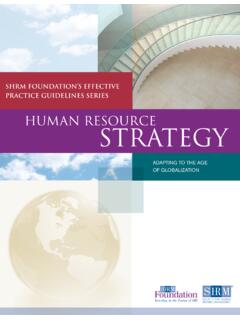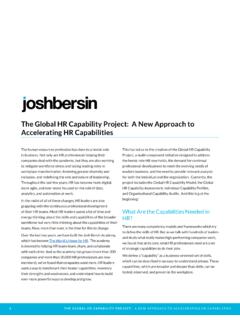Transcription of Succession Planning Toolkit - Human Resources
1 //////////////////////////////////////// //////////////////////////////////////// //////////////////////////////////////// /////////////////// W/////////////////////////////////////// //////////////////////////////////////// //////////////////////////////////////// ////////////////////////////M Succession Planning Toolkit Succession Planning is the process of identifying the critical positions within your organization and developing action plans for individuals to assume those positions. Taking a holistic view of current and future goals, this process ensures that you have the right people in the right jobs today and in the years to come. A Succession plan identifies future staffing needs and the people with the skills and potential to perform in these future roles. In the long term, Succession Planning strengthens the overall capability of the organization by: Identifying critical positions and highlighting potential vacancies; Selecting key competencies and skills necessary for business continuity; Focusing development of individuals to meet future business needs Included in this Toolkit are templates and tips for: Ensuring Succession Planning is closely tied to business strategy and goals; Understanding the importance of engaging executive and senior leaders in the process; Clearly defining the development of key talent; and Ensuring staff understand their role in the process and know what is expected of them.
2 If you need assistance in getting Succession Planning started in your organization, contact Professional & Organizational Development or your HR consultant. Beware of unconscious bias you may bring to Succession Planning . It is well documented that managers tend to hire and promote people who are like them. At the University of Washington, we strive to foster an inclusive and diverse workplace. We strongly recommend that Succession Planning is a collaborative process within your organization with a broad array of leaders adding input into the identification, selection, and mentoring process. Succession Planning PROCESS OVERVIEW ASSESS Identify significant business challenges in the next 1 5 years Identify critical positions that will be needed to support business continuity Identify competencies, skills and institutional knowledge that are critical success factors EVALUATE Consider high potential employees Select the competencies individuals will need to be successful in positions and to meet identified business challenges Categorize skill or competency gaps Predict the likelihood for attracting a robust and qualified candidate pool DEVELOP Capture the knowledge that individuals possess before departing the organization Develop a pool of talent to step into critical positions through targeted career development strategies STEP 1 Identify significant business challenges in the next 1 5 years Your department s strategic plan is a great place to start in identifying current and future challenges.
3 If your department doesn t have a strategic plan or it is not drilled down enough to your team s specific strategies and priorities, an environmental scan can provide you with enough information to start the Succession Planning process. ENVIRONMENTAL SCAN WORKSHEETE nvironmental scans can be conducted during a brainstorming session at a team meeting, as part of a management retreat, through surveying or talking with stakeholders, or by a combination of these methods. Participants:Date:What s happening inside and outside your Right now? In the near future ? In the distant future ?0 0 0 0 0 0 0 0 STEP 2 Identify critical positions that will be needed to support business continuity Since the next step involves identifying critical positions that your Succession plan will be built around, we recommend your department s HR administrator and/or assigned HR consultant be involved in this part of the process. CRITICAL POSITION WORKSHEETR eview positions at the director level and above to determine which positions are key.
4 Also, consider including individual contributor positions that require a particularly unique skillset, are traditionally hard to recruit for, or have a high turnover rate. Evaluate the impact each position has in achieving the strategic goals and objectives, as well as the vacancy risk and marketability of the Title:Position Payroll Title:Position Status: Filled VacantPOSITION IMPACT: High Medium Low Assessment of Position Impact should be based on a prioritized list of the department s mission, goals, objectives and strategic plan. VACANCY RISK: High Medium Low Assessment of Vacancy Risk should be based on factors such as the incumbent s retirement eligibility, marketability, 0 0 STEP 3 Identify competencies, skills and institutional knowledge that are critical success factors $fter you determine which positions are mission critical and have a significant vacancy risk, identify competencies, skills and institutional knowledge that are critical success factors for each of the positions that require a Succession plan.
5 CRITICAL SUCCESS FACTOR WORKSHEETP osition Title:Position Payroll Title:Education: (degrees, certifications, licensure) Work Experiences: CORE COMPETENCIES TECHNICAL COMPETENCIES Communication Project Management Strategic Planning Policy Development and Analysis Building Productive Relationships Budget and Fiscal Management Continuously Improving Quality Human Resources Management Developing Self Legal Compliance Focusing on Customers Computer Systems & Technology Valuing Cultural Diversity Program Development Managing Change Data Analysis Developing and Coaching Others Grants and Contract ManagementOther skills? IDENTIFY UNIQUE INSTITUTIONAL KNOWLEDGE OR RELATIONSHIPS What unique institutional knowledge or relationships are inherent to the success of this position?Does anyone else have this knowledge in the organization? If so, who?How critical is it that this knowledge is documented and shared? High Medium Low PLAN FOR SHARING KNOWLEDGE process documentation mentoring job aids job rotation job shadowing other:0 0 0 0 STEP 4 Consider high potential employees After you have evaluated which positions require a Succession plan, the next step is to consider if there are current sta members ready to successfully assume the role or have potential to grow into it over time.
6 Working with your HR administrator or HR consultant, determine which staff members are currently eligible or may be eligible within 3-5 years for prioritized positions. If you are conducting this Succession Planning exercise as a leadership team, be aware that high potential employees are often not distributed evenly within an organization. Be willing to have honest conversations and remember that just because an individual is not identified as high potential doesn t mean that they are not a strong individual contributor, nor should they be denied access to professional development activities. HIGH POTENTIAL EMPLOYEE IDENTIFICATIONName:Position Title:Unit:Years in Current Position:Current Supervisor:Target Position:Target Position Key Competencies:Ready: now within 1 year within 2 years within 3 5 yearsACTION PLAN: STEP 5 Select the competencies individuals will need to be successful in positions and to meet identified business challenges CAREER DEVELOPMENT PLAN WORKSHEET Name:Position Title:Unit: Supervisor Name:Supervisor Title:LONG TERM GOALS What are your long term career goals over the next 3 5 years?
7 Describe how your long term goals fit in with the goals and priorities of your department? 1. 2. (continued)Preparing an individual to progress in the organization is not a cookie-cutter process. It often takes a combination of formal training, thoughtful coaching, trusted mentorship, and key assignments. Managers and executive leadership play a key role in creating access/removing barriers to key assignments and providing honest feedback along the way. Managers should be having ongoing career development conversations with all employees in addition to their annual performance reviews. Career development conversations with high potential employees should be focused on closing the gaps and/or strengthen existing skills and development should be a part of your organization s regular HR practices and not only reserved for high potential individuals. Contact POD for more information about developing a department-wide career development program.
8 1 r J J 1 J L J SHORT TERM GOALS What are your career goals for the next year or two (these may or may not be the same as your annual performance goals)? Describe how your short term goals fit in with the goals and priorities of your 2. 3. DEVELOPMENT PLAN WORKSHEET (page 2) SKILL AND COMPETENCY REQUIREMENTS What skills or competencies do you need to build to reach your goals? This career development plan provides an opportunity to demonstrate your career potential and is not a guarantee of a promotion. The plan should be evaluated at least every six months and adjusted as needed based on organizational and/or personal priorities. _____ / _____ Employee signature & date_____ / _____ Supervisor signature & dateSkill or Competency to be DevelopedTraining Activities(formal training, mentorship, cross training, independent learning, etc.)Target DatesAssociated CostsRESULTS W/////////////////////////////////////// //////////////////////////////////////// //////////////////////////////////////// /////////////////////////////A UNIVERSITY of WASHINGTON CAREER DEVELOPMENT CHEATSHEET What do you want to strengthen?
9 Organizational Wherewithal Try cross-functional committee work, job rotation, and job shadowing Participate in UW events Assign responsibility for reading and understanding leadership messages Find opportunities to participate on UW-wide committees Attend meet-and-greets with targeted colleagues from other UW departments Arrange for mentoring by a leader from another UW department Register for POD courses ( ) Toastmasters University Knowledge and Understanding Communication Skills Position-Specific Expertise Management Skills Leadership Skills Investigate: professional certifications relevant courses conferences journal subscriptions research projects self-study SLP Level 1 ( ) SLP Level 2 ( ) Mentorship with a senior leader Leadership coaching ( ) UW ARC 360 ( leaders/orgdev/alliance/arc360 ) Mentorship with a senior leader Stretch assignments to lead department-wide teams and initiatives Before going into a career development discussion or collaborating on the Career Development Plan Worksheet, managers should prepare by reflecting on the following questions: What are the employee s career goals?
10 Are they realistic? Are they compatible with the organizational goals and needs? What actions has the employee completed so far? How successful were they? In what areas do you think the employee needs to develop new or more refined skills? Are there additional skills or competencies the employee should focus on to achieve their desired career goal? What Resources , training, or experience can you provide to help them reach their goal? Is there additional knowledge, certification, or education the employee needs to acquire? What shifts in current priority or workload can you accommodate to ensure the employee has bandwidth to pursue development opportunities? JUNE 29, 2016

